Workshop “Conformal higher spins, twistors and boundary calculus”
Conformal geometry and its generalisations emerge in many different areas, including CFT, (flat space) holography, boundary calculus and asymptotic symmetries, as well as twistor methods in field theory. Remarkably, all these themes become intertwined around conformal higher spin (CHS) gravities which are higher spin extensions of conformal (Weyl) gravities, and these theories suggest a vast generalisation of conformal geometry. In particular, CHS gravities generate various conformally-invariant operators and are closely related to conformal anomalies. Moreover, CHS fields can be identified as boundary values of massless fields in AdS space via Feffermann-Graham expansion. In low dimensions, another kind of geometry becomes important, namely twistor geometry, which is crucial for studying self-dual (conformal) theories, including higher spin gravities. The purpose of this workshop is to bring together mathematicians and physicists interested in these research directions.
- Xavier Bekaert (U. Tours)
- Andreas Čap (University of Vienna)
- Michael Eastwood (University of Adelaide)
- Rod Gover (University of Auckland)
- Yannick Herfray (U. Tours)
- Euihun Joung (Kyung Hee University)
- Jarosław Kopiński (University of California, Davis)
- Kirill Krasnov (Nottingham University)
- Sergei Kuzenko (University of Western Australia)
- Ruben Manvelyan (Yerevan Physics Institute)
- Lionel Mason (Oxford University)
- Tristan McLoughlin (Trinity College Dublin)
- Rodrigo Olea (Pontificia Universidad Católica de Valparaíso)
- Jan Slovák (Masaryk University)
- Dmitri Sorokin (Padua U.)
- Andrew Waldron (University of California, Davis)
| Monday | |
| 10:00 - 11:00 | Kirill Krasnov |
| 11:00 - 11:30 | Coffee break |
| 11:30 - 12:30 | Xavier Bekaert |
| 12:30 - 14:00 | Lunch |
| 14:00 - 15:00 | Thomas Basile (Review) |
| 15:00 - 16:00 | Euihun Joung |
| 16:00 - | Reception/BBQ |
| Tuesday | |
| 10:00 - 11:00 | Michael Eastwood |
| 11:00 - 11:30 | Coffee break |
| 11:30 - 12:30 | Lionel Mason |
| 12:30 - 14:00 | Lunch |
| 14:00 - 15:00 | Tristan McLoughlin |
| 15:00 - 16:00 | Yannick Herfray |
| 16:00 - 16:30 | Coffee break |
| 16:30 - 17:30 | Gong-show |
| Wednesday | |
| 10:00 - 11:00 | Rod Gover |
| 11:00 - 11:30 | Coffee break |
| 11:30 - 12:30 | Andreas Čap |
| 12:30 - 14:00 | Lunch |
| 14:00 - 15:00 | Jan Slovák |
| 15:00 - 16:00 | Rodrigo Olea |
| 16:00 - 16:30 | Coffee break |
| 16:30 - 17:30 | Ruben Manvelyan |
| 19:00 - | Conference dinner |
| Thursday | |
| 10:00 - 11:00 | Jarosław Kopiński |
| 11:00 - 11:30 | Coffee break |
| 11:30 - 12:30 | Andrew Waldron |
| 12:30 - 14:00 | Lunch |
| 14:00 - 15:00 | Dmitri Sorokin |
| 15:00 - 16:00 | Sergei Kuzenko |
| 16:00 - 16:30 | Coffee break |
Monday
Kirill Krasnov | 4D gravity via triples of 2-forms
Abstract: I will describe a formalism, originating in Plebanski’s work of 1978, in which a four-dimensional metric is encoded into a triple of 2-forms satisfying a set of algebraic relations. This formulation brings out the rich underlying geometry of General Relativity, particularly the concept of self-duality in four dimensions.
I will present a modern perspective on this formalism that develops it in a completely self-contained manner. In particular, I will show how the appropriate notions of connection and curvature naturally emerge by applying basic results from the representation theory of the orthogonal group.
I will then outline several key applications. First, the formalism provides a particularly natural language for describing gravitational instantons—Riemannian metrics with self-dual or anti-self-dual Riemann curvature—which correspond, in this framework, to closed triples of 2-forms. Second, I will describe an application to the computation of gravity MHV amplitudes, where the same diagrammatic tools as in Yang–Mills theory—Feynman diagrams and Berends–Giele recursion—can be employed to compute amplitudes in gravity. Third, I will explain how the linearisation of the gravitational instanton equations gives rise to an elliptic complex of differential operators, in direct analogy with the corresponding complex in the Yang–Mills case.
Xavier Bekaert | BMS particles: continuous spins and higher spins
Abstract: Generic unitary irreducible representations (UIRs) of the Bondi-Metzner-Sachs (BMS) group are considered. They are shown to describe quantum superpositions of (Poincaré) particles propagating on inequivalent gravity vacua. This follows from reconsidering McCarthy’s classification of BMS group UIRs through a unique, Lorentz-invariant but non-linear, decomposition of supermomenta into hard and soft pieces. The branching rules of generic UIRs for the restriction of BMS group to a Poincaré subgroup typically include continuous spins and higher spins in the BMS multiplet.
Thomas Basile | Conformal higher spins: a brief overview
Euihun Joung | Conformal fields as boundary degrees of freedom
Abstract: I will show and discuss how one can obtain conformal (HS) fields as boundary degrees of freedom of bulk topological (HS) fields.
Tuesday
Michael Eastwood | Conformal, projective, and Weyl geometries
Abstract: Mostly, this talk will be a review known constructions and especially the links between them. The formulae governing conformal and projective differential geometry already reveal striking similarities, really just the tip of the iceberg. We’ll use representation theory to take a look at what's going on underwater and, for example, use their invariant differential operators and some tricks based on twistor theory to draw some conclusions. Weyl geometry adds a connection to a conformal structure and then one can ask about the geodesics of this connection. Well, this is really a question in the projective realm: if time permits, I’ll provide some answers obtained in recent joint work with Omid Makhmali.
Lionel Mason | Twistor actions for chiral higher spin fields and nolinear higher spin structures
Abstract: This talk will present the CR-holomorphic Chern-Simons theories defined on the unit sphere or hyperboloid in non-projective twistor space and discuss their transform to chiral integrable higher spine theories in space-time, both in perturbation theory and in aspects of the nonlinear structures that tie the infinite sequence of higher spin theories together. This is joint work with Atul Sharma arxiv:2505.09419 building on earlier twistorial work by a number of authors.
Tristan McLoughlin | Celestial holography on non-trivial backgrounds
Yannick Herfray | Extended boundaries at time and spatial infinity
Wednesday
Rod Gover | Higher Yang-Mills energies and conformal Yang-Mills renormalisation
Abstract: Given a gauge connection on a Riemannian 4-manifold, the norm squared of its curvature gives a Lagrangian density whose integral is the Yang-Mills action/energy -- the variation of which gives the celebrated Yang-Mills equations. An important feature of both this energy and the equations is their conformal invariance in dimension 4.
A natural question is whether there are analogous objects in higher dimensions. We prove that there are such conformally invariant objects on even dimensional manifolds equipped with a connection. One proof, in dimension six, uses a type of Q-curvature that one can associate to connections, and we investigate applications of the result to conformal gravity type equations. Another proof uses a Poincaré-Einstein manifold in one higher dimension and a suitable Dirichlet problem for the interior Yang-Mills equations on this structure. The higher Yang-Mills equations arise from an obstruction to smoothly solving the asymptotic problem, while the higher energy is a log term (the so-called anomaly term) in the asymptotic expansion of the divergent interior energy. More arises including links to the non-local renormalised Yang-Mills energy, and a related higher non-linear Dirichlet-Neumann operator.
This is joint work with Emanuele Latini, Andrew Waldron, and Yongbing Zhang.
Andreas Čap | Flat extensions of connection forms and Chern-Simons invariants
Abstract: The main topic of my talk will be a general notion of connection forms on principal fiber bundles and of a concept of "flat extension" of such connection forms. The starting point of the talk will be joint work with K. Flood and T. Mettler, which studies invariants of Chern-Simons type associated to such connection forms. These generalize the classical ($\mathbb R/\mathbb Z$-valued) Chern-Simons invariant for oriented Riemannian 3-manifolds and the ($\mathbb R$-valued) Burns-Epstein invariant of a compact oriented 3-dimensional CR manifold that admits a global CR vector field. Flat extensions provide a conceptual way to obtain conditions that ensure vanishing or integrality of these invariants. Applications to Lorentzian metrics, affine connections, and to parabolic contact structures on 3-manifolds are discussed. In the second part of the talk, I'll discuss flat extensions of Cartan connections and potential applications of this concept.
Jan Slovák | Curved translation principle in generalised conformal calculus
Abstract: As well known, invariant linear differential operators are understood via homomorphisms between the duals of the infinite jets, the so called induced modules. For a large class of geometries this works on their Klein models like at the conformal sphere. Extending this algebraic approach to curved geometries leads us to semi-holonomic jets, as clarified in the old paper by Mike Eastwood and myself, aiming at the example of conformal Riemannian geometry, more than 25 years back (Journal of Algebra, 1997). I shall remind those concepts and tools in general, focusing on one explicit example of Grassmannian geometries. The talk is based on a recent work with Vladimir Soucek.
Rodrigo Olea | Conformal Renormalization, Holographic Entanglement Entropy and Willmore Energy
Abstract: Conformal Renormalization scheme provides the required boundary counterterms in Einstein-AdS gravity by embedding the latter theory in a particular type of Conformal Gravity. Indeed, in the Einstein sector of this Conformal Gravity, the action is equivalent to the one given by standard holographic techniques within the AdS/CFT framework.
In this talk, we show that the evaluation of the action of this Conformal Gravity in 6D on manifolds with conical defects leads to a singular contribution interpreted as a conformally invariant surface functional. This codimension-2 energy functional reduces to a renormalized form of Holographic Entanglement Entropy for minimal surfaces. For arbitrary surfaces, in turn, it generalizes the notions of Hawking Mass and Willmore energy to higher dimensions.
Ruben Manvelyan | Boundary Correlators and Bulk Cubic Interactions for Higher Spins: Constructive Approach and Anomaly
Abstract: We propose for correlation functions of the same spin conformal currents the general hypothesis that the Osborn-Petkou structural tensor of higher spins satisfying the right symmetry conditions can be obtained from the combination of the principal terms of spin one and two structural tensors raised to the degree corresponding to the value of spin s. We verify this hypothesis for the case of spin three and four and show that the construction of the conserved three-point function can be reduced to the algebraic task of canceling the right-hand sides of the divergences of constructed terms. It follows from this consideration that for spin three and four cases our solutions can be interpreted as the CFT-dual to the cubic interaction in the AdS space with one dimension more. Another benefit of this consideration could be the investigation of the higher spin conformal anomaly structure arising from singular behaviour of three-point correlation function in d = 4.
Thursday
Jarosław Kopiński | Conformal geometry of spacetimes with prescribed asymptotic behavior
Abstract: Our universe can be modeled as a solution to the Einstein field equations beginning with an initial Big Bang singularity and evolving toward a late-time phase of exponential expansion driven by a positive cosmological constant. I will show how tractor calculus can be applied to describe the asymptotic behavior of this model at early and late times. This approach establishes a connection between the stress-energy tensor and the geometric quantities associated with the hypersurfaces representing the regularized initial and final states.
Andrew Waldron | Yang-Mills Theory on Conformally Compact Manifolds
Abstract: The Yang-Mills equations are central to the study of smooth 4-manifolds and particle interactions. We consider Yang-Mills theory in the setting of conformally compact manifolds in general dimensions. In particular, we obtain a formula for the renormalized energy of Yang-Mills solutions on Poincaré-Einstein 6-manifolds. The method generalizes the proof of Chang-Qing-Yang for renormalized volumes to a broader setting.
Dmitri Sorokin | Non-linear duality-symmetric and chiral p-form theories: recent developments
Abstract: We will discuss the structure of a generic non-linear duality-symmetric electrodynamics in D=4 and a non-linear chiral 2-form theory in D=6, as well as a number of examples, from the perspective of their interpretation as stress-tensor (TTbar-like) deformations of conformal (free and ModMax) theories. The role and a form of higher-order invariants of tensor fields in the construction of Lagrangians of these theories will be explained. The situation with higher-dimensional, in particular D=10 non-linear chiral 4-form theories will be briefly highlighted.
Sergei Kuzenko | Conformal higher spins and duality invariance
Abstract: This talk will review the formalism of duality rotations for bosonic conformal spin-s gauge fields, with s>1, in a conformally flat four-dimensional spacetime. This approach is an extension of the general theory of U(1) duality-invariant nonlinear electrodynamics (spin 1) on an arbitrary spacetime background, which was developed in the late 1990s. For each integer spin >1, families of conformal U(1) duality-invariant models will be shown to exist, including a generalisation of the so called ModMax electrodynamics (s=1). We will review the field-theoretic approach to conformal geometry in D spacetime dimensions as the gauge theory of the conformal group. This approach will be presented in a modern setting that has been used to develop superspace formulations for conformal supergravity theories in diverse dimensions.
Our formalism of duality rotations has been extended to conformal gauge fields of Lorentz type (m/2, n/2), for positive integers m and n, as well as to arbitrary superspin and supersymmetry type. Such generalisations will not be discussed in this talk due to time constraints.
Abstract: We introduce a well-known approach, called orbit method, which deals with the particle worldline action on symplectic phase space. And we try to generalize the procedure to apply it to string theory. To do this, we analyse some mathematical tools such as multisymplectic structure and moment map. Finally, we try to make the constrained Hamiltonian system of string theory.
Ivan Dneprov | Gauging spacetime symmetries and coupling to background
Abstract: One is often interested in coupling a given gauge field theory to some background geometry in a way compatible with symmetries. We will hint at a possible approach to this problem which relies on rephrasing the background geometry as a non-lagrangian gauge theory and finding a "compatible" presymplectic structure which allows to restore the action using the presymplectic AKSZ prescription. The presymplectic structure can be often deduced from the presymplectic structure defining the original theory (i.e. theory restricted to some particular flat background). This procedure can be seen as a version of gauging spacetime symmetries.
Alejandro García Rivas | (Pre)quantized contact manifolds
Abstract: Many objects on a contact manifold (M,H) arise after fixing a contact 1-form representing H. Examples of these structures are Hamiltonian vector fields, Jacobi brackets, momentum maps and prequantum bundles. This approach has two main disadvantages: firstly, a globally defined contact form must exist, and secondly, different choices of the contact form determine different objects. The main goal of this short talk is to explain the realization of contact manifolds as symplectic principal R^*-bundles done by Grabowska and Grabowski. After that, we exploit this symplectic structure to produce ambient versions of the above objects that, after picking a local contact form, actually reduce to the well-known definitions.
Julian Lang | A Lightcone Formalism for Bulk Lightcones
Abstract: Lightcone-gauges depend on a foliation of space-time into null-hyperplanes, which are lightcones of points at the asymptotic boundary of space-time. We show that in de Sitter space, one can instead define a lightcone-gauge which foliates spacetime into lightcones of bulk-points. Using certain higher-spin self-dual theories we show that using lightcones of bulk-points provides us with an increased freedom in the description of the theory, without leading to additional complications when compared to boundary lightcones. We use this freedom to establish a relationship between different lightcone-gauges. Lastly, we show how our results are relevant for the problem of static-patch scattering.
Vasileios Letsios | Non-standard conformal symmetry and unitary rigid supersymmetry for the chiral graviton and chiral gravitino in de Sitter spacetime
Abstract: It is well known that the graviton and gravitino gauge potentials in Minkowski and (A)dS spacetime—i.e., strictly massless spin-2 and spin-3/2 fields—do not exhibit conformal so(4,2) symmetry, nor do higher-spin gauge potentials. However, in (A)dS backgrounds, their complexified gauge potentials enjoy a lesser-known invariance under non-standard conformal-like transformations. While the symmetry algebra still closes on so(4,2), these transformations differ from the usual infinitesimal conformal transformations.
Focusing on the chiral graviton and gravitino fields, I will show how this non-standard conformal symmetry plays a central role in enabling a unitary realization of rigid supersymmetry on de Sitter spacetime—something long thought to be impossible.
Mikhail Markov | Boundary structure of asymptotically AdS gravity in the Gauge PDE formalism
Abstract: In this presentation, I will show how the Gauge PDE formalism, some version of the non-Lagrangian BV-AKSZ formalism, can be used for a coordinate-free and gauge-invariant formulation of the gauge theory induced on the (asymptotic) boundary of the spacetime. In the case of asymptotically AdS spacetimes (possibly with additional gauge fields), this leads to an analogue of the Fefferman–Graham construction that is automatically consistent with gauge invariance.
TaeHwan Oh | Twistorial Descriptions of AdS Particles
Abstract: I will discuss the twistorial formulation of massive and massless particles from coadjoint orbits, especially four-dimensional cases.
Davide Rovere | 8d Conformal Gravity with an Einstein Sector
Abstract: We compute the most general action in eight dimensional conformal gravity, such that all Einstein AdS spaces are solutions of the equations of motion, starting from an arbitrary combination of a basis of independent 8d conformal invariants. The action is unique, up to boundary terms, and it is on-shell equivalent to the Hilbert-Einstein action plus the Euler topological term. This result is the first step in investigating the equivalence with the usual holographic renormalisation, similarly to the four and the six dimensional cases.
Work to appear w/ G. Anastasiou, I. Araya, N. Boulanger, and R. Olea.
Dmitry Rudinsky | Weak gauge PDEs
Abstract: Gauge PDEs are flexible graded geometrical objects that generalise AKSZ sigma models to the case of local gauge theories. However, aside from specific cases — such as PDEs of finite type or topological field theories — gauge PDEs are inherently infinite-dimensional. It turns out that these objects can be replaced by finite dimensional objects called weak gauge PDEs. Weak gauge PDEs are equipped with a vertical involutive distribution satisfying certain properties, and the nilpotency condition for the homological vector field is relaxed so that it holds modulo this distribution. Moreover, given a weak gauge PDE, it induces a standard jet-bundle BV formulation at the level of equations of motion. In other words, all the information about PDE and its corresponding BV formulation turns out to be encoded in the finite-dimensional graded geometrical object. Examples include scalar field theory and self-dual Yang-Mills theory.
Kirill Krasnov | 4D gravity via triples of 2-forms
Abstract: I will describe a formalism, originating in Plebanski’s work of 1978, in which a four-dimensional metric is encoded into a triple of 2-forms satisfying a set of algebraic relations. This formulation brings out the rich underlying geometry of General Relativity, particularly the concept of self-duality in four dimensions.
I will present a modern perspective on this formalism that develops it in a completely self-contained manner. In particular, I will show how the appropriate notions of connection and curvature naturally emerge by applying basic results from the representation theory of the orthogonal group.
I will then outline several key applications. First, the formalism provides a particularly natural language for describing gravitational instantons—Riemannian metrics with self-dual or anti-self-dual Riemann curvature—which correspond, in this framework, to closed triples of 2-forms. Second, I will describe an application to the computation of gravity MHV amplitudes, where the same diagrammatic tools as in Yang–Mills theory—Feynman diagrams and Berends–Giele recursion—can be employed to compute amplitudes in gravity. Third, I will explain how the linearisation of the gravitational instanton equations gives rise to an elliptic complex of differential operators, in direct analogy with the corresponding complex in the Yang–Mills case.
Xavier Bekaert | BMS particles: continuous spins and higher spins
Abstract: Generic unitary irreducible representations (UIRs) of the Bondi-Metzner-Sachs (BMS) group are considered. They are shown to describe quantum superpositions of (Poincaré) particles propagating on inequivalent gravity vacua. This follows from reconsidering McCarthy’s classification of BMS group UIRs through a unique, Lorentz-invariant but non-linear, decomposition of supermomenta into hard and soft pieces. The branching rules of generic UIRs for the restriction of BMS group to a Poincaré subgroup typically include continuous spins and higher spins in the BMS multiplet.
Thomas Basile | Conformal higher spins: a brief overview
Euihun Joung | Conformal fields as boundary degrees of freedom
Abstract: I will show and discuss how one can obtain conformal (HS) fields as boundary degrees of freedom of bulk topological (HS) fields.
Tuesday
Michael Eastwood | Conformal, projective, and Weyl geometries
Abstract: Mostly, this talk will be a review known constructions and especially the links between them. The formulae governing conformal and projective differential geometry already reveal striking similarities, really just the tip of the iceberg. We’ll use representation theory to take a look at what's going on underwater and, for example, use their invariant differential operators and some tricks based on twistor theory to draw some conclusions. Weyl geometry adds a connection to a conformal structure and then one can ask about the geodesics of this connection. Well, this is really a question in the projective realm: if time permits, I’ll provide some answers obtained in recent joint work with Omid Makhmali.
Lionel Mason | Twistor actions for chiral higher spin fields and nolinear higher spin structures
Abstract: This talk will present the CR-holomorphic Chern-Simons theories defined on the unit sphere or hyperboloid in non-projective twistor space and discuss their transform to chiral integrable higher spine theories in space-time, both in perturbation theory and in aspects of the nonlinear structures that tie the infinite sequence of higher spin theories together. This is joint work with Atul Sharma arxiv:2505.09419 building on earlier twistorial work by a number of authors.
Tristan McLoughlin | Celestial holography on non-trivial backgrounds
Yannick Herfray | Extended boundaries at time and spatial infinity
Wednesday
Rod Gover | Higher Yang-Mills energies and conformal Yang-Mills renormalisation
Abstract: Given a gauge connection on a Riemannian 4-manifold, the norm squared of its curvature gives a Lagrangian density whose integral is the Yang-Mills action/energy -- the variation of which gives the celebrated Yang-Mills equations. An important feature of both this energy and the equations is their conformal invariance in dimension 4.
A natural question is whether there are analogous objects in higher dimensions. We prove that there are such conformally invariant objects on even dimensional manifolds equipped with a connection. One proof, in dimension six, uses a type of Q-curvature that one can associate to connections, and we investigate applications of the result to conformal gravity type equations. Another proof uses a Poincaré-Einstein manifold in one higher dimension and a suitable Dirichlet problem for the interior Yang-Mills equations on this structure. The higher Yang-Mills equations arise from an obstruction to smoothly solving the asymptotic problem, while the higher energy is a log term (the so-called anomaly term) in the asymptotic expansion of the divergent interior energy. More arises including links to the non-local renormalised Yang-Mills energy, and a related higher non-linear Dirichlet-Neumann operator.
This is joint work with Emanuele Latini, Andrew Waldron, and Yongbing Zhang.
Andreas Čap | Flat extensions of connection forms and Chern-Simons invariants
Abstract: The main topic of my talk will be a general notion of connection forms on principal fiber bundles and of a concept of "flat extension" of such connection forms. The starting point of the talk will be joint work with K. Flood and T. Mettler, which studies invariants of Chern-Simons type associated to such connection forms. These generalize the classical ($\mathbb R/\mathbb Z$-valued) Chern-Simons invariant for oriented Riemannian 3-manifolds and the ($\mathbb R$-valued) Burns-Epstein invariant of a compact oriented 3-dimensional CR manifold that admits a global CR vector field. Flat extensions provide a conceptual way to obtain conditions that ensure vanishing or integrality of these invariants. Applications to Lorentzian metrics, affine connections, and to parabolic contact structures on 3-manifolds are discussed. In the second part of the talk, I'll discuss flat extensions of Cartan connections and potential applications of this concept.
Jan Slovák | Curved translation principle in generalised conformal calculus
Abstract: As well known, invariant linear differential operators are understood via homomorphisms between the duals of the infinite jets, the so called induced modules. For a large class of geometries this works on their Klein models like at the conformal sphere. Extending this algebraic approach to curved geometries leads us to semi-holonomic jets, as clarified in the old paper by Mike Eastwood and myself, aiming at the example of conformal Riemannian geometry, more than 25 years back (Journal of Algebra, 1997). I shall remind those concepts and tools in general, focusing on one explicit example of Grassmannian geometries. The talk is based on a recent work with Vladimir Soucek.
Rodrigo Olea | Conformal Renormalization, Holographic Entanglement Entropy and Willmore Energy
Abstract: Conformal Renormalization scheme provides the required boundary counterterms in Einstein-AdS gravity by embedding the latter theory in a particular type of Conformal Gravity. Indeed, in the Einstein sector of this Conformal Gravity, the action is equivalent to the one given by standard holographic techniques within the AdS/CFT framework.
In this talk, we show that the evaluation of the action of this Conformal Gravity in 6D on manifolds with conical defects leads to a singular contribution interpreted as a conformally invariant surface functional. This codimension-2 energy functional reduces to a renormalized form of Holographic Entanglement Entropy for minimal surfaces. For arbitrary surfaces, in turn, it generalizes the notions of Hawking Mass and Willmore energy to higher dimensions.
Ruben Manvelyan | Boundary Correlators and Bulk Cubic Interactions for Higher Spins: Constructive Approach and Anomaly
Abstract: We propose for correlation functions of the same spin conformal currents the general hypothesis that the Osborn-Petkou structural tensor of higher spins satisfying the right symmetry conditions can be obtained from the combination of the principal terms of spin one and two structural tensors raised to the degree corresponding to the value of spin s. We verify this hypothesis for the case of spin three and four and show that the construction of the conserved three-point function can be reduced to the algebraic task of canceling the right-hand sides of the divergences of constructed terms. It follows from this consideration that for spin three and four cases our solutions can be interpreted as the CFT-dual to the cubic interaction in the AdS space with one dimension more. Another benefit of this consideration could be the investigation of the higher spin conformal anomaly structure arising from singular behaviour of three-point correlation function in d = 4.
Thursday
Jarosław Kopiński | Conformal geometry of spacetimes with prescribed asymptotic behavior
Abstract: Our universe can be modeled as a solution to the Einstein field equations beginning with an initial Big Bang singularity and evolving toward a late-time phase of exponential expansion driven by a positive cosmological constant. I will show how tractor calculus can be applied to describe the asymptotic behavior of this model at early and late times. This approach establishes a connection between the stress-energy tensor and the geometric quantities associated with the hypersurfaces representing the regularized initial and final states.
Andrew Waldron | Yang-Mills Theory on Conformally Compact Manifolds
Abstract: The Yang-Mills equations are central to the study of smooth 4-manifolds and particle interactions. We consider Yang-Mills theory in the setting of conformally compact manifolds in general dimensions. In particular, we obtain a formula for the renormalized energy of Yang-Mills solutions on Poincaré-Einstein 6-manifolds. The method generalizes the proof of Chang-Qing-Yang for renormalized volumes to a broader setting.
Dmitri Sorokin | Non-linear duality-symmetric and chiral p-form theories: recent developments
Abstract: We will discuss the structure of a generic non-linear duality-symmetric electrodynamics in D=4 and a non-linear chiral 2-form theory in D=6, as well as a number of examples, from the perspective of their interpretation as stress-tensor (TTbar-like) deformations of conformal (free and ModMax) theories. The role and a form of higher-order invariants of tensor fields in the construction of Lagrangians of these theories will be explained. The situation with higher-dimensional, in particular D=10 non-linear chiral 4-form theories will be briefly highlighted.
Sergei Kuzenko | Conformal higher spins and duality invariance
Abstract: This talk will review the formalism of duality rotations for bosonic conformal spin-s gauge fields, with s>1, in a conformally flat four-dimensional spacetime. This approach is an extension of the general theory of U(1) duality-invariant nonlinear electrodynamics (spin 1) on an arbitrary spacetime background, which was developed in the late 1990s. For each integer spin >1, families of conformal U(1) duality-invariant models will be shown to exist, including a generalisation of the so called ModMax electrodynamics (s=1). We will review the field-theoretic approach to conformal geometry in D spacetime dimensions as the gauge theory of the conformal group. This approach will be presented in a modern setting that has been used to develop superspace formulations for conformal supergravity theories in diverse dimensions.
Our formalism of duality rotations has been extended to conformal gauge fields of Lorentz type (m/2, n/2), for positive integers m and n, as well as to arbitrary superspin and supersymmetry type. Such generalisations will not be discussed in this talk due to time constraints.
Gong-show:
Minkyeu Cho | Multisymplectic geometry and Brane actionAbstract: We introduce a well-known approach, called orbit method, which deals with the particle worldline action on symplectic phase space. And we try to generalize the procedure to apply it to string theory. To do this, we analyse some mathematical tools such as multisymplectic structure and moment map. Finally, we try to make the constrained Hamiltonian system of string theory.
Ivan Dneprov | Gauging spacetime symmetries and coupling to background
Abstract: One is often interested in coupling a given gauge field theory to some background geometry in a way compatible with symmetries. We will hint at a possible approach to this problem which relies on rephrasing the background geometry as a non-lagrangian gauge theory and finding a "compatible" presymplectic structure which allows to restore the action using the presymplectic AKSZ prescription. The presymplectic structure can be often deduced from the presymplectic structure defining the original theory (i.e. theory restricted to some particular flat background). This procedure can be seen as a version of gauging spacetime symmetries.
Alejandro García Rivas | (Pre)quantized contact manifolds
Abstract: Many objects on a contact manifold (M,H) arise after fixing a contact 1-form representing H. Examples of these structures are Hamiltonian vector fields, Jacobi brackets, momentum maps and prequantum bundles. This approach has two main disadvantages: firstly, a globally defined contact form must exist, and secondly, different choices of the contact form determine different objects. The main goal of this short talk is to explain the realization of contact manifolds as symplectic principal R^*-bundles done by Grabowska and Grabowski. After that, we exploit this symplectic structure to produce ambient versions of the above objects that, after picking a local contact form, actually reduce to the well-known definitions.
Julian Lang | A Lightcone Formalism for Bulk Lightcones
Abstract: Lightcone-gauges depend on a foliation of space-time into null-hyperplanes, which are lightcones of points at the asymptotic boundary of space-time. We show that in de Sitter space, one can instead define a lightcone-gauge which foliates spacetime into lightcones of bulk-points. Using certain higher-spin self-dual theories we show that using lightcones of bulk-points provides us with an increased freedom in the description of the theory, without leading to additional complications when compared to boundary lightcones. We use this freedom to establish a relationship between different lightcone-gauges. Lastly, we show how our results are relevant for the problem of static-patch scattering.
Vasileios Letsios | Non-standard conformal symmetry and unitary rigid supersymmetry for the chiral graviton and chiral gravitino in de Sitter spacetime
Abstract: It is well known that the graviton and gravitino gauge potentials in Minkowski and (A)dS spacetime—i.e., strictly massless spin-2 and spin-3/2 fields—do not exhibit conformal so(4,2) symmetry, nor do higher-spin gauge potentials. However, in (A)dS backgrounds, their complexified gauge potentials enjoy a lesser-known invariance under non-standard conformal-like transformations. While the symmetry algebra still closes on so(4,2), these transformations differ from the usual infinitesimal conformal transformations.
Focusing on the chiral graviton and gravitino fields, I will show how this non-standard conformal symmetry plays a central role in enabling a unitary realization of rigid supersymmetry on de Sitter spacetime—something long thought to be impossible.
Mikhail Markov | Boundary structure of asymptotically AdS gravity in the Gauge PDE formalism
Abstract: In this presentation, I will show how the Gauge PDE formalism, some version of the non-Lagrangian BV-AKSZ formalism, can be used for a coordinate-free and gauge-invariant formulation of the gauge theory induced on the (asymptotic) boundary of the spacetime. In the case of asymptotically AdS spacetimes (possibly with additional gauge fields), this leads to an analogue of the Fefferman–Graham construction that is automatically consistent with gauge invariance.
TaeHwan Oh | Twistorial Descriptions of AdS Particles
Abstract: I will discuss the twistorial formulation of massive and massless particles from coadjoint orbits, especially four-dimensional cases.
Davide Rovere | 8d Conformal Gravity with an Einstein Sector
Abstract: We compute the most general action in eight dimensional conformal gravity, such that all Einstein AdS spaces are solutions of the equations of motion, starting from an arbitrary combination of a basis of independent 8d conformal invariants. The action is unique, up to boundary terms, and it is on-shell equivalent to the Hilbert-Einstein action plus the Euler topological term. This result is the first step in investigating the equivalence with the usual holographic renormalisation, similarly to the four and the six dimensional cases.
Work to appear w/ G. Anastasiou, I. Araya, N. Boulanger, and R. Olea.
Dmitry Rudinsky | Weak gauge PDEs
Abstract: Gauge PDEs are flexible graded geometrical objects that generalise AKSZ sigma models to the case of local gauge theories. However, aside from specific cases — such as PDEs of finite type or topological field theories — gauge PDEs are inherently infinite-dimensional. It turns out that these objects can be replaced by finite dimensional objects called weak gauge PDEs. Weak gauge PDEs are equipped with a vertical involutive distribution satisfying certain properties, and the nilpotency condition for the homological vector field is relaxed so that it holds modulo this distribution. Moreover, given a weak gauge PDE, it induces a standard jet-bundle BV formulation at the level of equations of motion. In other words, all the information about PDE and its corresponding BV formulation turns out to be encoded in the finite-dimensional graded geometrical object. Examples include scalar field theory and self-dual Yang-Mills theory.
- Thomas Basile (UMONS)
- Xavier Bekaert (U. Tours)
- Nicolas Boulanger (UMONS)
- Andrea Campoleoni (UMONS)
- Andreas Čap (University of Vienna)
- Minkyeu Cho (Kyung Hee University)
- Raikhik Das (University of Edinburgh)
- William Delplanque (UMONS)
- Shailesh Dhasmana (UMONS)
- Ivan Dneprov (UMONS)
- Michael Eastwood (University of Adelaide)
- Felipe Figueroa (UMONS)
- Alejandro García Rivas (University of Bologna)
- Rod Gover (University of Auckland)
- Robin Guarini (UMONS)
- Maxim Grigoriev (UMONS)
- Yannick Herfray (U. Tours)
- Euihun Joung (Kyung Hee University)
- Jarosław Kopiński (University of California, Davis)
- Kirill Krasnov (Nottingham University)
- Sergei Kuzenko (University of Western Australia)
- Julian Lang (OIST)
- Vasileios Letsios (UMONS)
- Guillaume Lhost (UMONS)
- Iva Lovrekovic (TU Wien)
- Nicolas Maindiaux (UMONS)
- Ruben Manvelyan (Yerevan Physics Institute)
- Mikhail Markov (UMONS)
- Lionel Mason (Oxford University)
- Tristan McLoughlin (Trinity College Dublin)
- Lea Mele (UMONS)
- Evangelos Nastas
- Josh O'Connor (UMONS)
- TaeHwan Oh (KIAS)
- Rodrigo Olea (Pontificia Universidad Catolica de Valparaiso)
- Noémie Parrini (UMONS)
- Simon Pekar (SISSA)
- Davide Rovere (University of Padova)
- Mattia Serrani (UMONS)
- Evgeny Skvortsov (UMONS)
- Jan Slovák (Masaryk University)
- Dmitri Sorokin (Padua U.)
- Arseny Sukhanov (UMONS)
- Sylvain Thomée (UMONS)
- Richard Van Dongen (UMONS)
- Matthieu Vilatte (UMONS)
- Andrew Waldron (University of California, Davis)
Registration
If you wish to attend the meeting please send an email to Evgeny.SKVORTSOV@umons.ac.beHow to reach the conference venue
- Direct trains from Zaventem airport to Mons are available every hour. You only have to be careful to look for trains directed to Bergen, which is the Dutch name of Mons; alternatively, you can reach the station Brussels Midi and take a train to Mons;
- Charleroi airport is connected to Mons by a shuttle bus (bus schedule);
- Trains from Brussels to Mons are running every half an hour, starting around h:25 and h:56 from Midi station (please crosscheck the train schedule!);
- The workshop will take place in the UMONS campus “Plaine de Nimy”, that can be reached from Mons train station in 20/25 minutes by walk (see the precise address below). A limited number of blue-bikes is also available at the train station;
- The talks will take place in the centre Vésale, room 020 on Monday and Tuesday, and in the De Vinci building, room Mirzakhani, on Wednesday and Thursday (map of the campus).
The De Vinci building has two entrances, which are shown in the images below, as well as directions to get to the Mirzakhani room, where the talks will take place.
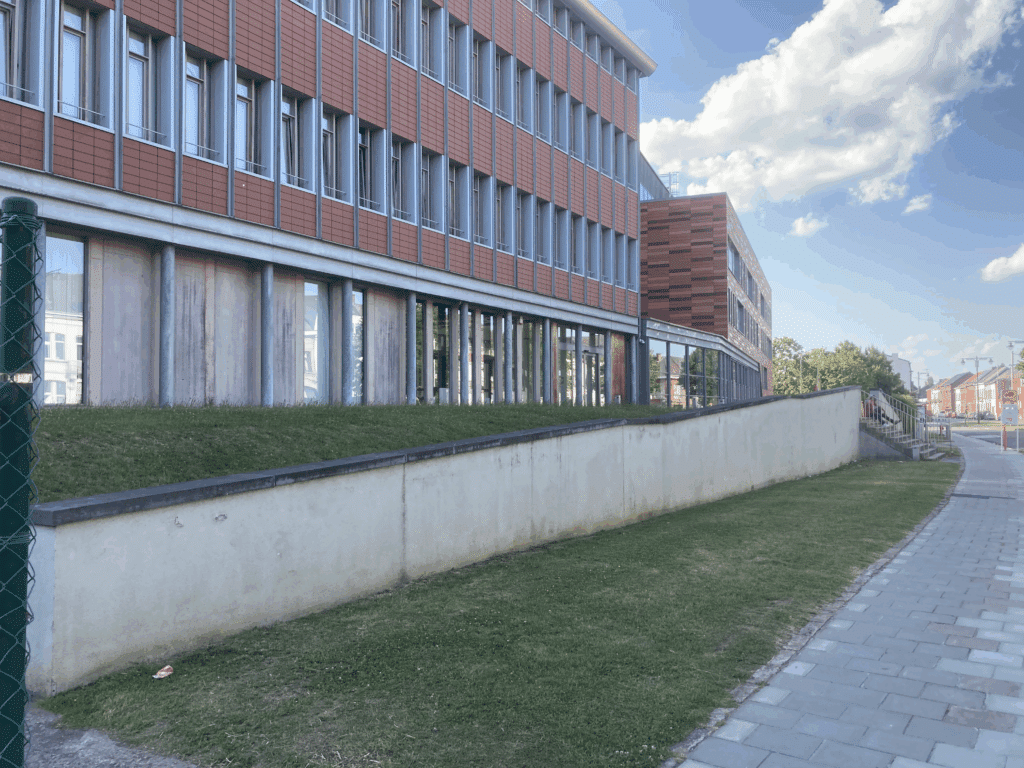
Entrance 1 of the De Vinci building (avenue Maistriau). 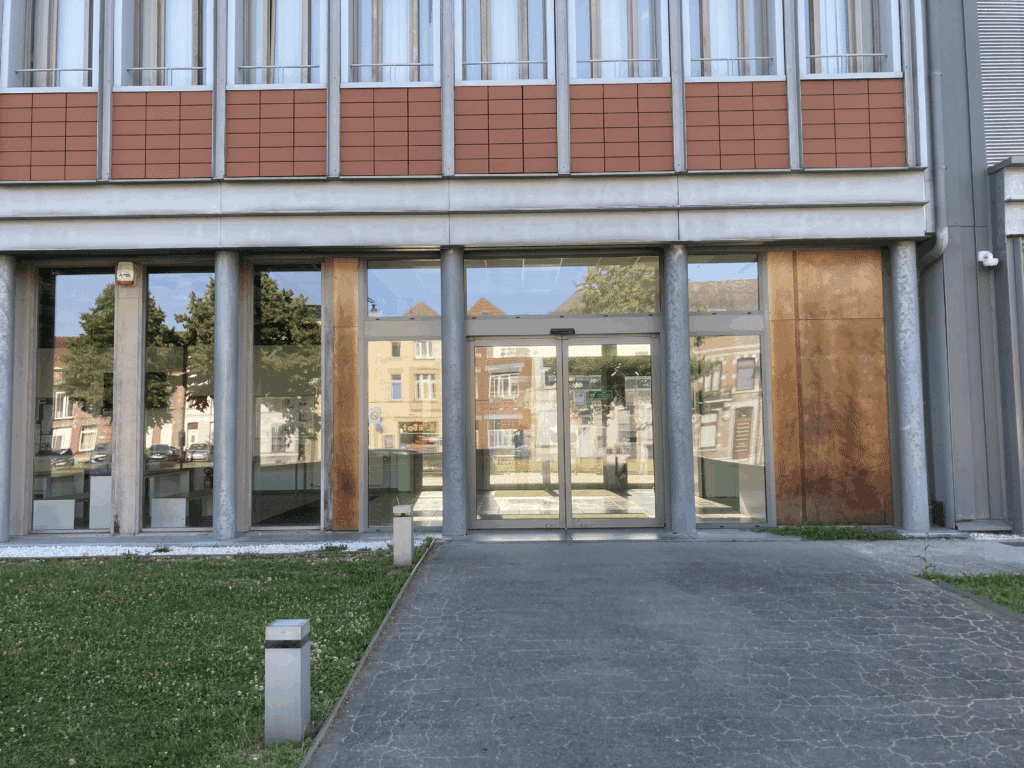
Entrance 1 of the De Vinci building (closer view). 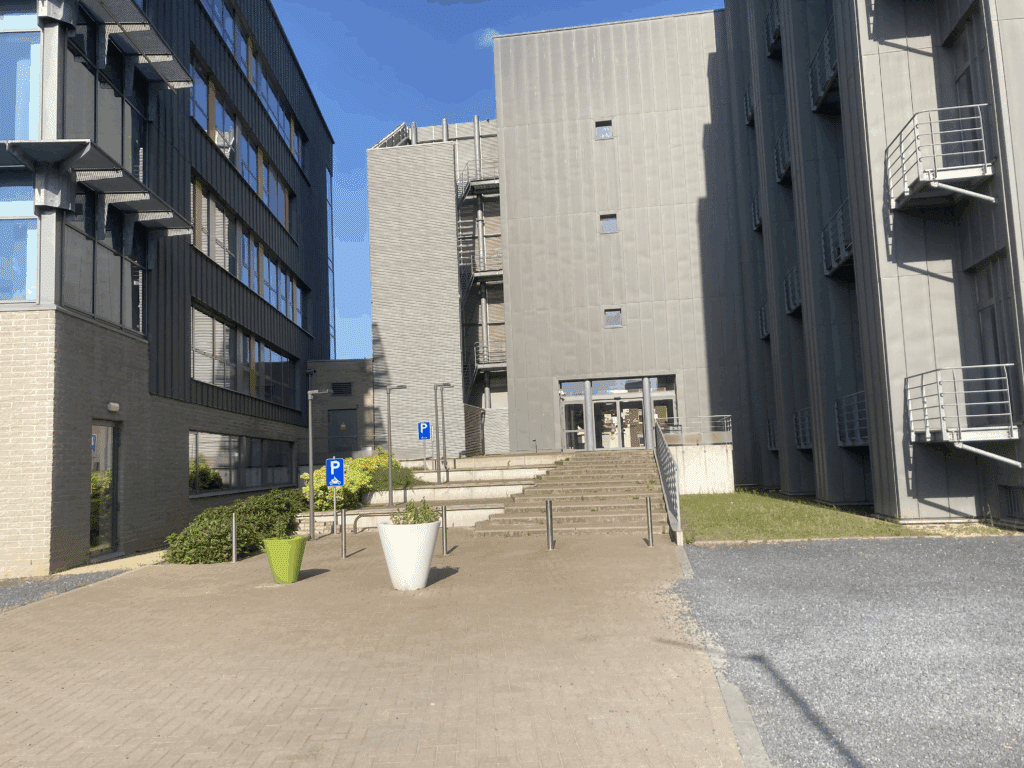
Entrance 2 of the De Vinci building (inside the campus). 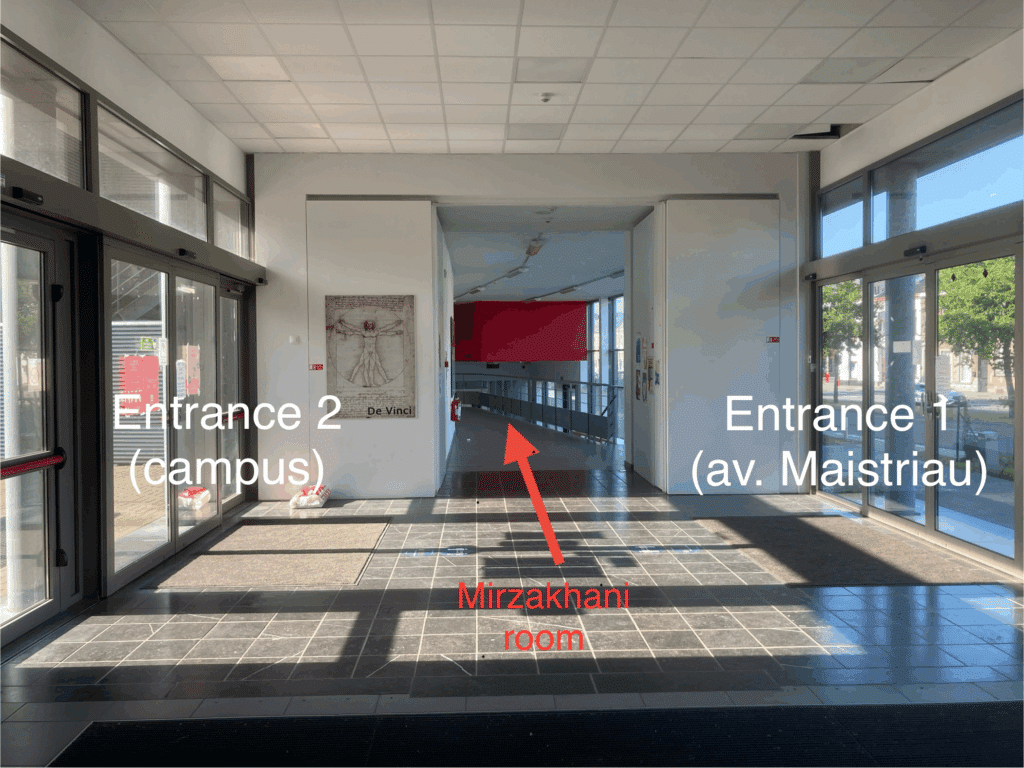
Path to the Mirzakhani room (1/5) 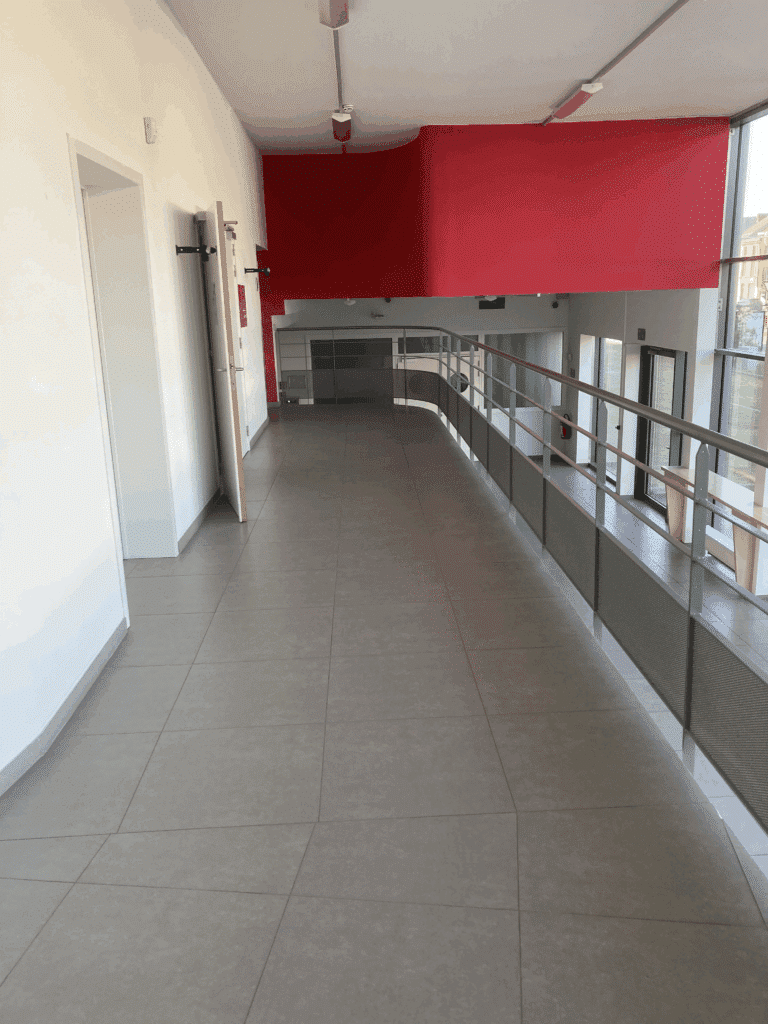
Path to the Mirzakhani room (2/5) 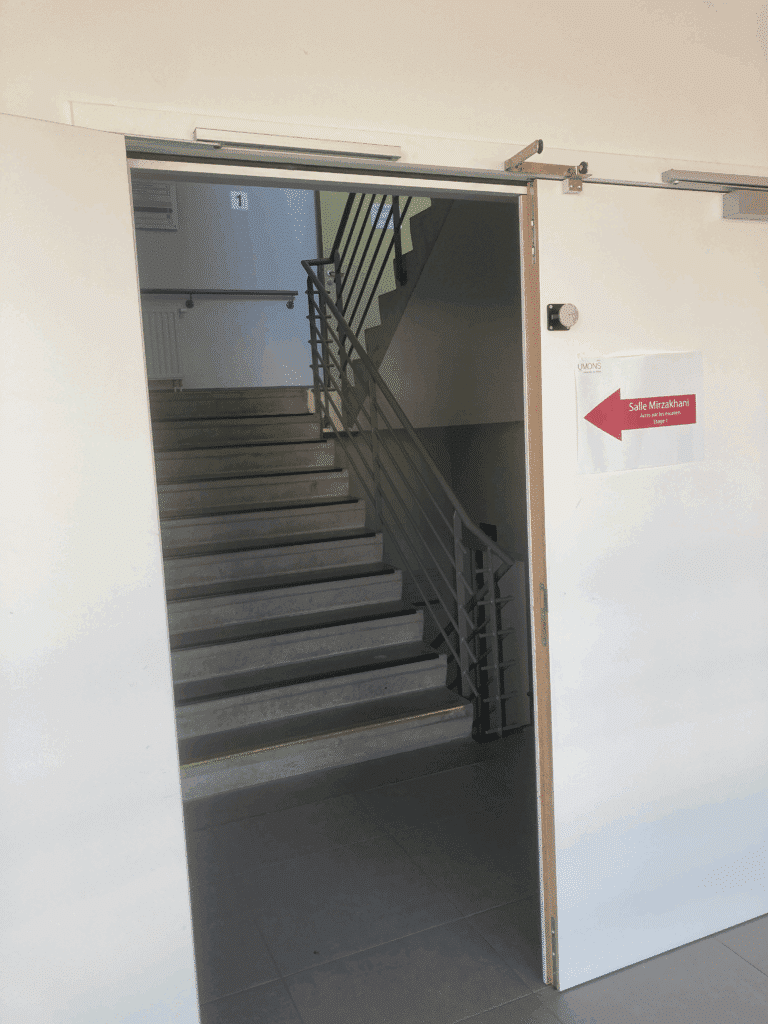
Path to the Mirzakhani room (3/5) 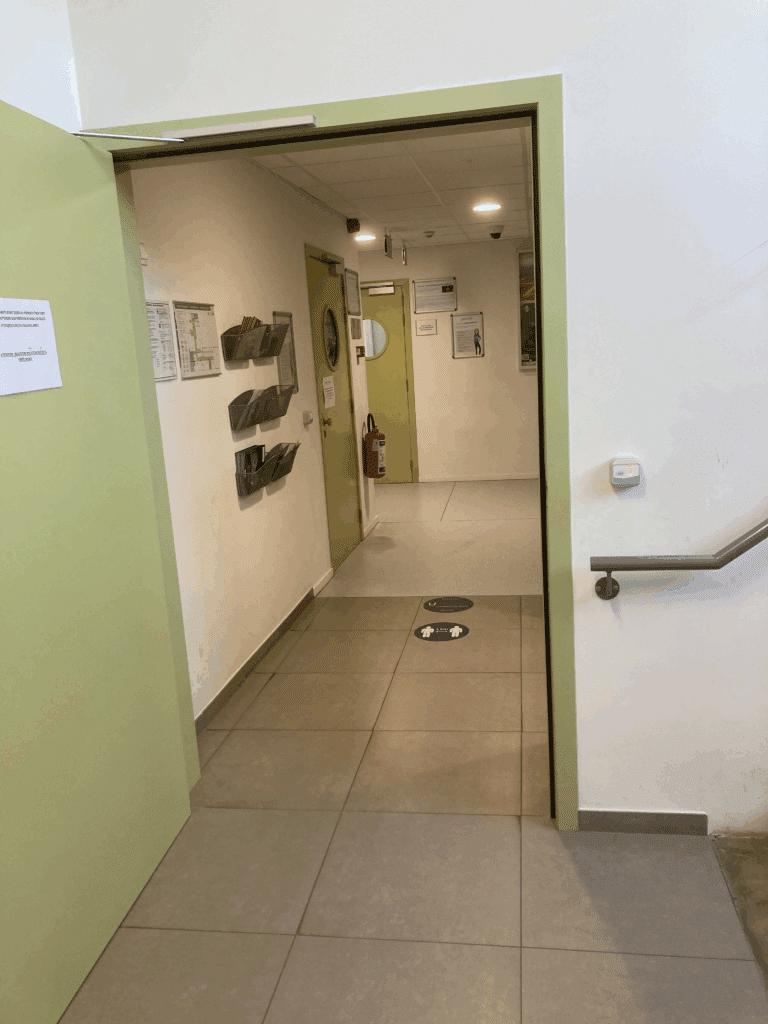
Path to the Mirzakhani room (4/5) 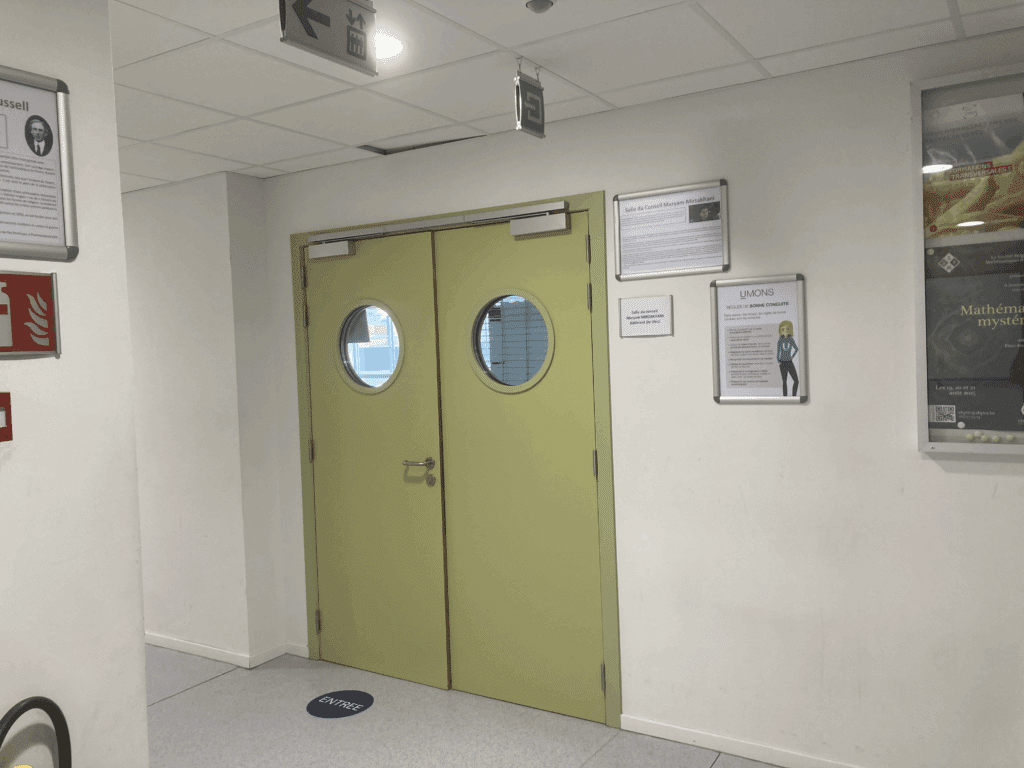
Path to the Mirzakhani room (5/5)
Accommodation
- B&B Hotel Mons centre (10 min by foot from the workshop venue)
- Saint Georges Hotel (10 min by foot from the workshop venue)
- Martin's Dreams Hotel (30 min by foot from the workshop venue)
Address
Avenue Maistriau, 19
7000 Mons, Belgium
7000 Mons, Belgium

